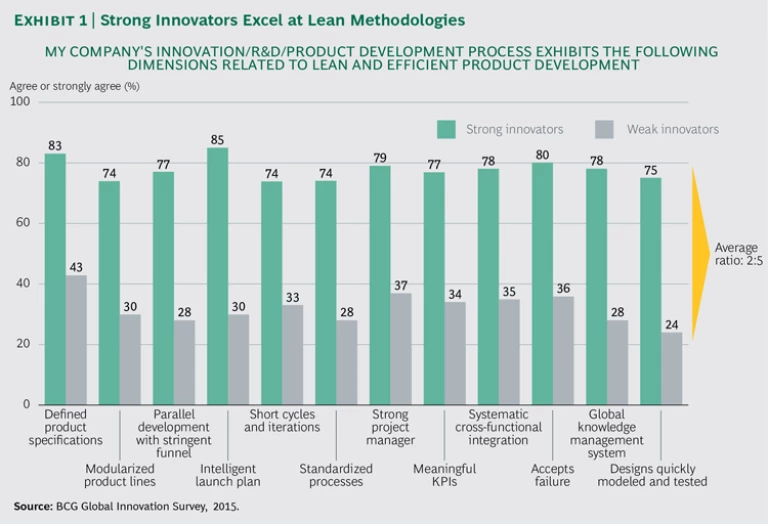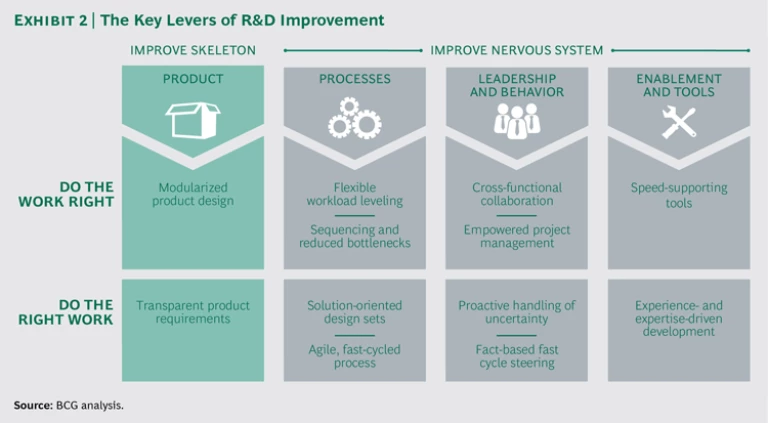This article is an excerpt from The Most Innovative Companies 2015: Four Factors that Differentiate Leaders (BCG report, December 2015).
Department store magnate John Wanamaker’s famous lament, “Half the money I spend on advertising is wasted; the trouble is I don’t know which half,” could easily be applied to R&D and new-product development. And when annual R&D spending reaches $1 billion, $5 billion, $10 billion or more, the amounts being “wasted” get very big, very fast.
It’s not that companies are profligate, of course; creative functions such as new-product development are never 100% efficient, and they involve a certain amount of trial, error, and, inevitably, failure. But the fact is that some companies are considerably more successful at R&D than others, and having strong processes in place is one of the four attributes that executives say are critical to success. What can companies do to improve their R&D processes?
Managing the Unmanageable
It seems almost counterintuitive that strong innovators would emphasize process. After all, R&D is a creative function, and too much process management runs the risk of squelching the very creativity that is the lifeblood of innovation. The conventional wisdom is that the best creative minds want freedom, and any sort of process management represents manacles that either drive them away or, worse, keep them onboard but fettered from creating the value they are capable of delivering.
Yet the data is unequivocal—and compelling. In this year’s survey of the state of innovation at companies worldwide, we asked respondents for the first time to rate their companies’ innovation and product development activities on 12 dimensions related to lean and efficient product development, including short cycles and iterations, standardized processes, and the quick modeling and testing of designs. The overall responses were roughly 50% to 60% positive. But when we segmented them by strong versus weak innovators, the percentage of strong innovators following lean principles jumped to 74% or more—on every single dimension. Strong innovators are two to three times more likely to adhere to lean principles than their weak counterparts. (See Exhibit 1.)
The impact can be substantial. Separate BCG research has shown that the companies that are first to master lean R&D methodologies gain significant competitive advantages by developing higher-quality products up to six months sooner than their competitors, while also reducing deviations from product target costs by more than 35%. Moreover, in our experience, when organizations apply the principles of lean process improvement customized for the creative process of R&D, the typical result is a 15% to 20% improvement in R&D productivity.
This isn’t to say that these companies focus solely on efficiency in the narrow sense of per unit cost. In R&D, being productive is as much about being smart about which bets to make—à la John Wanamaker—as it is about pursuing those bets efficiently. But the best companies put a process in place that enables good decision-making as well as good execution. (See The Lean Advantage in Engineering, BCG Focus, April 2015.)
Doing the Work Right…and the Right Work
This two-fold focus of process design—on execution as well as on decision-making—is captured by the mantra, “Do the work right, and do the right work.” (See Exhibit 2.) Do the work right is all about the process of execution, and it involves the same principles that are core to the lean approach in manufacturing and other domains: eliminating waste, reducing costs, shortening timelines, improving quality, and increasing efficiency. The best companies have designed processes that focus on the following aspects of execution:
- Planning, Scheduling, and Approval: avoiding late or inadequate planning, lack of sequence in scheduling, and unclear or overly iterative approval processes
- Standardization and Automation: minimizing variation and maximizing efficiency
- Role Clarity and Scalability: ensuring coordination and consolidation of key functions for critical mass and the reuse of assets and information
- In-house Expertise: building and maintaining expertise and properly deploying scarce resources
- Sourcing and Geographic Distribution: pursuing the proper use of outsourcing and offshoring with the right level of oversight
- Metrics, Monitoring, and Feedback: maintaining transparency on costs and other metrics, and actively monitoring to drive responsive feedback loops
It’s in doing the right work, however, that R&D departs from lean as it applies to other domains. This is all about the process of decision-making, and it takes on far more importance in R&D because R&D is by nature a learning enterprise in which the freedom to follow untested hypotheses and hunches is critical.
Companies need to make all kinds of choices, such as which requirements to build into the target product profile, how best to pursue development for a given project, whether to run similar projects in sequence or in parallel, what priority to give projects that are competing for scarce resources, and—in the ultimate test of decision-making—when to call it a day and terminate a failing project.
All these decisions can be challenging, not just because of the inherent uncertainties in exploring the unknown, but also because the information necessary to make decisions is often held by specialists across multiple technical disciplines. It can be hard for a single individual or governance committee to have the expertise required to synthesize inputs from these disparate sources. This difficulty is exacerbated when the providers of the information have vested interests—such as job security, the desire to make a breakthrough, or the ability to work in a discipline of interest—that may promote (even unintentionally) optimism bias in their evaluations.
The best companies focus as strongly on improving the process of decision-making to offset this potential bias as they do on the process of execution. The principles they deploy include:
- Optimization Not Suboptimization. They avoid the temptation in large organizations to “push decisions down,” instead ensuring that those closest to a project have the ability to provide input but that trade-off decisions are made at a level above the units being evaluated.
- Courage. They are willing to make big bets, they don’t revisit decisions unless circumstances change, and they ban appeals outside the process.
- Attention to Cultural Issues That Promote Optimism Bias. They measure expert contributions by how much the input facilitates the governing body’s decision-making, thereby rewarding unbiased input.
- Real Differentiation in Investment Profiles. They identify the projects that should proceed at full speed, the ones that require staged investment in order to gain a better understanding of the risks, and the ones that need more analysis in order to answer key questions. These decisions are clearly communicated across the organization.
- Measurement on ROI. They avoid pushing through projects just to meet quotas or targets. They allow no unfunded mandates. All decisions are tied to budget implications.
To bring this two-fold focus on process excellence in decision-making and execution to life, consider the example of a European automotive OEM for which adopting lean methodology meant staying among the industry front-runners in cycle time. In doing the work right, the company addressed high R&D spending during physical testing, the last phase of development. It invested in ensuring prevalidation of designs using digital tools before physical testing and then extended this methodology back to suppliers. The cost of prototyping was cut in half, and the number of specification changes per component dropped by a staggering 75%.
As to doing the right work, given that only 15% of a vehicle’s technical specifications actually result in meaningful differentiation for consumers, the question—again à la John Wanamaker—was which 15%. This OEM made a significant investment in determining the attributes that consumers recognize as differentiating. It then did the hard work of translating those attributes into a technical roadmap that enabled the R&D department to focus its resources on the right 15%.
Lean methodologies in R&D are not implemented overnight, nor is a culture that embraces lean principles and processes created in weeks or months. Companies that want to truly transform their R&D and product development programs are looking at a journey that is likely to be measured in years. But for those that depend on innovation for growth, and back that dependence with budgets in the billions, the combination of cost savings and improved efficacy make it a journey well worth taking.







